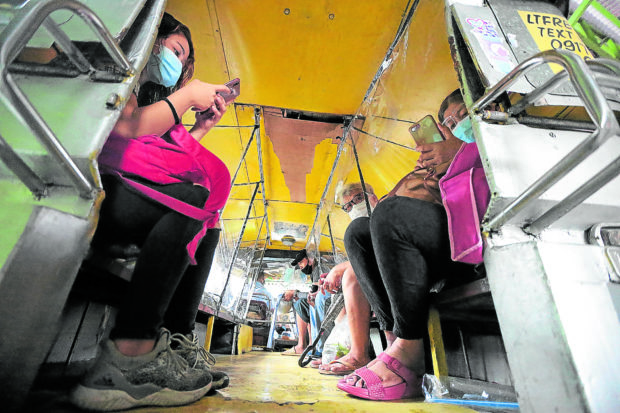70% public transport capacity allowed in Metro Manila, adjacent areas starting Nov. 4

Plastic dividers in PUVs will no longer be required starting Thursday, Nov. 4, 2021. (File photo by GRIG C. MONTEGRANDE / Philippine Daily Inquirer)
MANILA, Philippines — Beginning Thursday, Nov. 4, the allowed passenger capacity for public utility vehicles (PUVs) operating in Metro Manila and its four adjacent provinces – Bulacan, Rizal, Laguna, and Cavite — will be increased from the current 50% to 70%.
An increase in passenger capacity from the current 30% to 70% will also be implemented in the trains of the Light Rail Transit 1 and 2, Metro Rail Transit 3, and the Philippine National Railways.
Memorandum Circular 2021-064, which the Land Transportation Franchising and Regulatory Board (LTFRB), issued on Nov. 2, allowed the increased capacity “as a result of the continuous decline in COVID-19 infections and government’s aggressive COVID-19 vaccination roll-out.”
Days earlier, on Oct. 28, the Inter-Agency Task Force for the Management of Emerging Infectious Diseases (IATF-EID) approved the recommendation of the Department of Transportation (DOTr) and the LTFRB to implement the gradual increase in passenger capacity in public transportation, including road and railway systems, for a month until they had reached full capacity.
In a statement issued on Wednesday, LTFRB Chair Delgra explained that the increased capacity allowed was due to the growing demand for public transportation as quarantine restrictions began to be eased and more businesses had started reopening.
Article continues after this advertisementHe added that the increase in passenger capacity would help cushion the impact of the pandemic and the recent hike in fuel prices on the livelihood of PUV drivers and operators.
Article continues after this advertisement“The livelihood of public transport drivers and operators was severely affected with passenger capacity in public transport maintained at 50%. Increasing passenger capacity will mean higher revenue for the public transport sector, especially now that more people are allowed to go out. This is a big help to our fellow passengers and driver,” Delgra said in a mix of Filipino and English.
Strict health protocols still imposed
“Studies have shown that only 0.2% of traceable outbreaks in Germany were linked to transport; only 1.2% of COVID-19 clusters are linked to transport (land, air, and sea); and that there is only a 0.01% chance of contracting COVID-19 in public transportation, with the probability decreasing to 0.005% risk of infection with face covering,” Transportation Undersecretary TJ Batan said.
Still, the following measures will be strictly enforced in PUVs and trains:
- Wearing face masks and face shields
- No talking and making telephone calls
- No eating
- Keeping public transport well-ventilated
- Conducting frequent disinfection
- No passengers with COVID-19 symptoms are to be allowed inside public transportation
- Observing appropriate physical distancing
Plastic barriers are no longer required
The LTFRB also clarified that plastic barriers in public utility jeepneys nationwide would no longer be required, provided that passengers would observe proper physical distancing and other health protocols to prevent the spread of COVID-19.
“It was not the DOTr that required plastic barriers between passengers of public vehicles such as jeepneys,” Delgra said.
“The protocol that the DOTr put out when we were still under GCQ [general community quarantine] last year was the installation of a plastic barrier to separate the driver from the passengers,” he added.